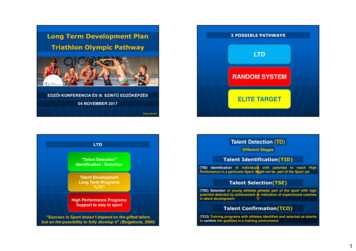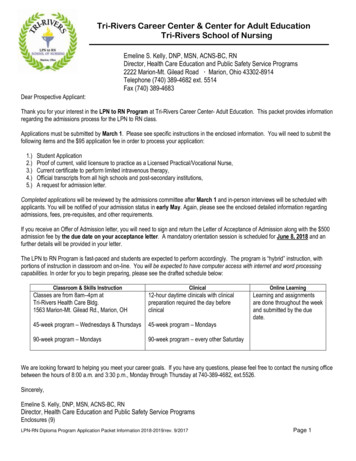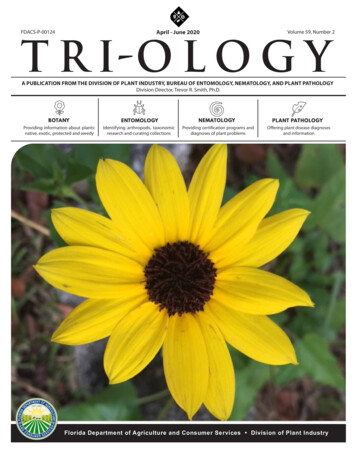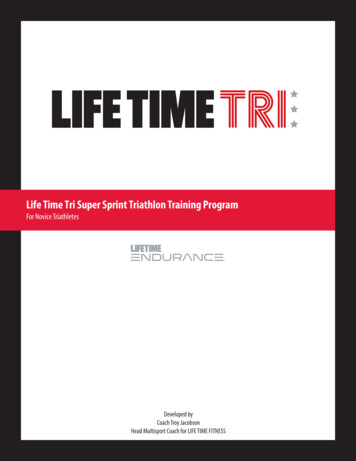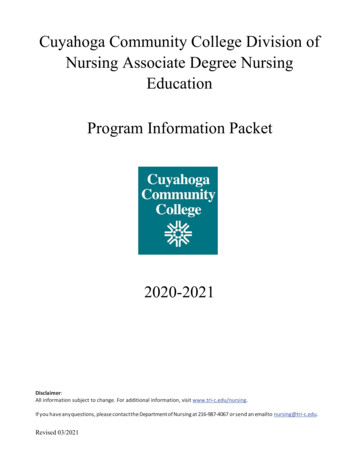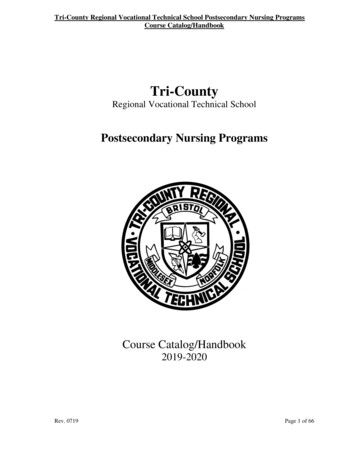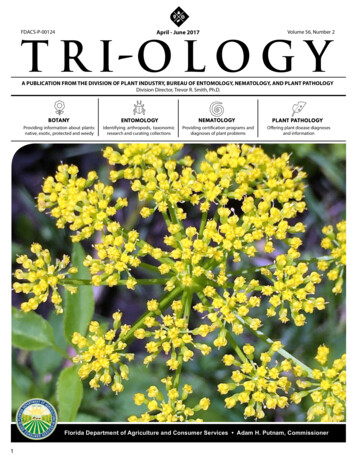
Transcription
T R I-O L O G YApril - June 2017FDACS-P-00124Volume 56, Number 2a publication from the division of plant industry, bureau of entomology, nematology, and plant pathologyDivision Director, Trevor R. Smith, Ph.D.BOTANYENTOMOLOGYNEMATOLOGYPLANT PATHOLOGYProviding information about plants:native, exotic, protected and weedyIdentifying arthropods, taxonomicresearch and curating collectionsProviding certification programs anddiagnoses of plant problemsOffering plant disease diagnosesand informationFlorida Department of Agriculture and Consumer Services Adam H. Putnam, Commissioner1
Ocyptamus fuscipennis (Say) 1823Photograph courtesy of Jeffrey W. Lotz, DPIABOUT TRI-OLOGYThe Florida Department of Agriculture and Consumer ServicesDivision of Plant Industry’s Bureau of Entomology, Nematology,and Plant Pathology (ENPP), including the Botany Section, producesTRI-OLOGY four times a year, covering three months of activity ineach issue.The report includes detection activities from nursery plantinspections, routine and emergency program surveys, and requestsfor identification of plants and pests from the public. Samples arealso occasionally sent from other states or countries for identificationor diagnosis.How to cite Tri-ologySection Editor. Year. Section Name. P.J. Anderson and G.S. Hodges(Editors). TRI-OLOGY Volume (number): page. [Date you accessed site.]For example: S.E. Halbert. 2015. Entomology Section. P.J. Andersonand G.S. Hodges (Editors). TRI-OLOGY 54(4): 9. [Accessed 5 June 2016.]Copies of TRI-OLOGY are kept on the FDACS website for two years. Toobtain older copies, contact the FDACS/DPI Library at (352) 395-4722.AcknowledgementsThe editors would like to acknowledge the work of all those whocontributed information and explanations by providing data,photographs or text, and by carefully reading early drafts.We welcome your suggestions for improvement of TRI-OLOGY.Please feel free to contact the helpline with your comments at1-888-397-1517.Thank you,Table of Contents03HighlightsNoteworthy examples from the diagnostic groups throughout the ENPP Bureau.04BOTANYQuarterly activity reports from Botany and selected plantidentification samples.ENTOMOLOGY07Quarterly activity reports from Entomology and samplesreported as new introductions or interceptions.NEMATOLOGY14Quarterly activity reports from Nematology and descriptionsof nematodes of special interest.Plant Pathology16Quarterly activity reports from Plant Pathology and selectedidentified plant pest and disease samples.FROM THE EDITOR20Articles of interest that vary in subject matter.Gregory Hodges, Ph.D.EditorAssistant Director, Division of Plant IndustryPatti J. Anderson, Ph.D.Managing EditorBotanist, Division of Plant Industry2Cover PhotoZizia aurea (L.)Koch (golden Alexanders).Photograph courtesy of Patti J. Anderson, DPI
Highlightsdulcis Park. (June plum, ambarella, golden apple)1andSpondiasis native to eastern Indonesia, Papua New Guinea and Polynesia,has been introduced to tropical areas worldwide, where itis cultivated for its fruit and its ornamental value. The plant isoccasionally grown in South Florida, as far north as Palm Beachand Collier counties. The fruit, produced in prolific quantities, isan oval drupe with a thick, inedible skin that turns from green togolden yellow as it ripens.Periconiella lygodii was submitted presenting as a leaf spot on2Lygodium japonicum (Japanese climbing fern) from a naturalarea located next to an industrial business in Duval County. Thefirst record of this fungus occurring on L. japonicum was reportedin the Philippines in 2008. This collection of P. lygodii is a newstate record.1 - Spondias dulcis (June plum, ambarella, golden apple) small tree.Photograph courtesy of Top Tropicalsbesseyi Christie, 1942, the rice white-tip3 Aphelenchoidesnematode or summer crimp nematode of strawberries,was detected in the buds of Fragaria x ananassa (strawberry).Aphelenchoides besseyi is a damaging parasite of rice in manyrice-producing areas of the United States. This foliar nematodeis frequently detected on ornamentals in Florida and can be aparasite of the buds of strawberries grown in Florida.neglectus (Kuznetzov), a mite, new Western4 NeopronematusHemisphere record, was originally described from the Black2 - Periconiella lygodii leaf spot symptoms on Lygodium japonicum (Japaneseclimbing fern).Photograph courtesy of Robert M. Leahy USDA/CAPS and Bradley A. DannerDPI/CAPSSea region in the Old World. It is not a plant feeder and is likelyto be a fungivore and/or predator.3 - Fragaria x ananassa (garden strawberry) showing damage caused byAphelenchoides besseyi.Photograph courtesy of Jason D. Stanley, DPI4 - Neopronematus neglectus (Kuznetzov), whole body of mite.Photograph courtesy of Samuel J. Bolton, DPI3
BotanyCompiled by Patti J. Anderson, Ph.D.This section identifies plants for the Division of Plant Industry, aswell as for other governmental agencies and private individuals.The Botany Section maintains a reference herbarium with over12,000 plants and 1,400 vials of seeds.Quarterly Activity ReportApriljuneSamples submittedby other DPI sectionsSamples submittedfor botanicalidentification onlyTotal samplessubmittedSpecimens added tothe Herbarium2017 - yearto date1,2792,2291342731,4132,502771391a - Cephalanthus occidentalis (common buttonbush).Photograph courtesy of Patricia HowellSome of the samples received for identification are discussedbelow:occidentalis L. (common buttonbush), from1 Cephalanthusa genus of six species native to tropical and warm regions.Rubiaceae. This widespread species is found in most counties ofFlorida and from Canada through the eastern half of the UnitedStates, as well as Mexico, California and the West Indies. This shrubor small tree grows to 4 m tall, along or in swamps, ponds, lakesand rivers and can be used as an ornamental plant in wet soils. Theglossy, green leaves with entire margins are opposite or whorledin groups of three to four at a node. The veins and midrib areprominent as is the interpetiolar stipule. Flowers are clustered ina spherical 2-3 cm head of individual, tubular, four-lobed, whiteflowers. The pistil is exerted from each tube in an arrangement thatreminds some people of a pin cushion pierced by straight pins.All parts of the plant contain phytochemicals that have provedtoxic to horses, but other animals reportedly consume the plantwithout injury. (Palm Beach County; B2017-244; Matthew M. Miller;2 June 2017 and Hendry County; B2017-272; Olga Garcia, USDA;27 June 2017.) (Hall et al. 2011; Hammer 2002; Mabberley 2008;Perkins and Payne 1978; Wunderlin and Hansen 2011; http://www.wildflower.org/plants/result.php?id plant CEOC2 [accessed 7 July2017]; anthusoccidentalis/ [accessed 5 July 2017].)41b - Cephalanthus occidentalis (common buttonbush) close view of flower.Photograph courtesy of Shirley Denton
dulcis Park. (Synonym S. cytherea Sonn.; June2 Spondiasplum, ambarella, golden apple) is from a genus of 10 speciesof trees native from Indomalesia to Southeast Asia and tropicalAmerica. Anacardiaceae. Native to eastern Indonesia, Papua NewGuinea and Polynesia, Spondias dulcis has been introduced totropical areas worldwide, where it is cultivated for its fruit and itsornamental value. The plant is occasionally grown in South Florida,as far north as Palm Beach and Collier counties. A fast-growing,drought-tolerant, dry-season deciduous tree, it can reach a heightof 10-20 m. Its alternate pinnately compound leaves have 9-25elliptic leaflets, 6-8 cm long, with slightly toothed margins. Tiny,whitish flowers are borne on terminal panicles. The fruit, producedin prolific quantities, is an oval drupe, 4-8 cm long, with a thick,inedible skin that turns from green to golden yellow as it ripens.The ripe flesh is juicy and flavorful, if somewhat tart and fibrous,with a consistency like that of a mango. This bright yellow pulpsurrounds a hard, fibrous, woody pit containing one to five seeds.Ripe fruits are eaten fresh, juiced to make a breakfast drink (likeorange juice) or made into jams and preserves. Crunchy immaturefruits are made into pickles and relishes or sliced and eaten withsalt, lime juice or chili sauce. Two related species with smallerfruits, S. mombin L. (yellow mombin, Spanish plum) and S. purpureaL. (purple mombin, jocote), are also cultivated in South Florida;S. purpurea has naturalized in Collier County. In the month ofJune, the Botany Section received six Spondias specimens foridentification, all from residential landscapes in Miami-Dadeand Broward counties. Three were S. dulcis. (Miami-Dade County;B2017-247; Miguel L. Justiz, USDA; 7 Jun 2017 and B2017-255and B2017-256; Miguel L. Justiz, USDA; 14 Jun 2017.) (Blancke2016; Boning 2006; Llamas 2003; Mabberley 2008; http://florida.plantatlas.usf.edu/Plant.aspx?id 1542 [accessed 20 June 2017].)(Dr. Paul T. Corogin.)2a - Spondias dulcis (ambarella, June plum, golden apple) small tree.Photograph courtesy of Top TropicalsReferencesBlancke, R. 2016. Tropical fruits and other edible plants of theworld: an illustrated guide. Cornell University Press, Ithaca,New York. 339 p.Boning, C.R. 2006. Florida’s best fruiting plants. Pineapple Press,Inc., Sarasota, Florida. 232 p.2b - Spondias dulcis (ambarella, June plum, golden apple) ripe fruit.Photograph courtesy of Cesar Calderon, USDA APHIS PPQ, Bugwood.orgHall, D.W., W.J. Weber and J.H. Byrd (ed.). 2011. Wildflowers ofFlorida and the Southeast. DW Hall Consulting, Gainesville,Florida. 820 p.Hammer, R. 2002. Everglades wildflowers. Falcon Press, Guilford,Connecticut. 231 p.Llamas, K.A. 2003. Tropical flowering plants: a guide to identificationand cultivation. Timber Press, Portland, Oregon. 423 p.Mabberley, D.J. 2008. Mabberley’s plant-book: a portable dictionaryof plants, their classification and uses, 3rd edition. CambridgeUniversity Press, New York, New York. 1,021 p.Perkins, K.D. and W.W. Payne. 1978. Guide to the poisonous andirritant plants of Florida. Florida Cooperative Extension Service.University of Florida, Gainesville, Florida. 91 p.Wunderlin, R.P. and B.F. Hansen. 2011. Guide to the vascular plantsof Florida, 3rd edition. University Press of Florida, Gainesville,Florida. 783 p.52c - Spondias purpurea (purple mombin, jocote), leaves and branch withripening fruit.Photograph courtesy of Top Tropicals
BOTANY identification tableThe following table provides information about new county records submitted in the current volume’s time period. The table isorganized alphabetically by collector name. The full version of all botany samples for the period is downloadable as a PDF or ExcelSpreadsheet.NEWRECORD6COLLECTOR 1COLLECTOR 2COUNTYSAMPLENUMBERCOLLECTIONDATEGENUSSPECIESMark R. TerrellHendryB2017-238May 25, 2017Euphorbiagraminea Jacq.Michael C.McMahanOkaloosaB2017-245May 25, 2017Passifloraincarnata L.Nora MarquezLakeB2017-175April 17, 2017Ardisiacrenata SimsTravis J. StreeterHillsboroughB2017-241May 24, 2017Ficuspumila L.
EntomologyCompiled by Susan E. Halbert, Ph.D.This section provides the division’s plant protection specialists and other customers with accurate identifications of arthropods.The Entomology Section also builds and maintains the arthropod reference and research collection (the Florida State Collectionof Arthropods (FSCA) with over 9 million specimens) and investigates the biology, biological control and taxonomy of arthropods.Quarterly Activity ReportApriljuneSamples submitted1,503Lots identified1,840Specimens identified13,1422017 - yearto dateSamples submitted2,660Lots identified3,310Specimens identified34,009Neopronematus neglectus (Kuznetzov), a mite, new Western1Hemisphere record. Although not previously identified here,this is a relatively common mite throughout Florida and possibly1a - Neopronematus neglectus, whole body of mite.Photograph courtesy of Samuel J. Bolton, DPIelsewhere in the Americas. This species was originally describedfrom the Black Sea region in the Old World. It has also been foundin Hungary and Iran. It is not a plant feeder and is likely to be afungivore and/or predator. This species can be distinguished fromother species of the genus by the relatively short setae on theopisthosoma, and a relatively short sensory structure (solenidion)on tarsus I. (Duval County; E2017-2086; Lisa M. Hassell; 24 May2017.) (Dr. Samuel J. Bolton.)sp., a tortricid moth, new Continental USA2 Crocidosemarecord. This seems to be an undescribed species. It was rearedon gray nickerbean plants (Caesalpinia bonduc) gathered to feedendangered Miami Blue butterfly caterpillars. The moth eclosedin March 2017. Older specimens cannot be found in the FSCA.Some congeners are pests, such as C. plebejana (Zeller) on cottonand okra, and C. longipalpana (Möschler) on litchi. Other relativesfeed on legumes, so the host fits a pattern. In addition to uniquegenitalia, the specimen has a distinctive combination of malecharacters, including androconia on the wings and abdomen,that are intermediate between the C. plebejana and C. lantanagroups. (Monroe County; E2017-1519; Sarah R. Steele Cabreraand Matthew J. Standridge, Florida Museum of Natural History,University of Florida; 22 February 2017.) (Dr. James E. Hayden.)1b - Neopronematus neglectus, the dorsum of the opishthosoma with setae labeled.Photograph courtesy of Samuel J. Bolton, DPI2 - Crocidosema species (a tortricid moth).Photograph courtesy of James E. Hayden, DPI7
rufipes (Eichhoff), the native elm bark beetle,3 Hylurgopinusnew Florida State Record. A single specimen of H. rufipeswas collected on March 21, 2017, in a green Lindgren funnel trapwith a z3-hexen-1-ol lure, in Ocala at Silver River State Park. Thefemale and male are similar in size and character, 2.2-2.5 mmlong and clothed in inconspicuous hair-like setae. This is the onlyspecies in the genus, and it occurs east of the Rocky Mountainsfrom Canada to the southern United States. Hylurgopinus rufipes isknown primarily from Ulmus spp., although it has been recordedfrom Fraxinus, Tilia and Prunus. (Marion County; E2017-1745;Bradley A. Danner, DPI/CAPS and Robert M. Leahy, USDA/CAPS;21 March 2017.) (Katherine E. O. Fairbanks.)Rhinacloa callicrates Herring, Parkinsonia bug, new Florida4State Record. This bug appears to be specific to Parkinsoniaaculeata. It is native to the western United States (California andArizona) and Mexico. Parkinsonia aculeata has become a weed inAustralia, and the mirid bug has been used as a biological controlagent there (Donnelly 2000). Rhinacloa callicrates is unlikely tobecome a pest in Florida. (Hillsborough County; E2017-1766;Travis J. Streeter; 7 May 2017.) (Dr. Susan E. Halbert.)3 - Hylurgopinus rufipes (elm bark beetle).Photograph courtesy of Katherine E. O. Fairbanks, DPIdorsalis (Hendel), Oriental fruit fly, regulatory5 Bactroceraincident. A single male specimen was trapped in a Jacksontrap baited with methyl eugenol in a mango tree in Clearwater.Increased trap densities in a 66-square mile area around thedetection site will be maintained and traps monitored closely foran estimated two life cycles (until approximately 6 August 2017)if no further flies are found. (Pinellas County; E2017-2251; RichardWhite; 6 June 2017.) (Dr. Gary J. Steck.)Tinea translucens Meyrick, a tropical casemaking clothes6moth, Notable Find. This pest is closely related to the commoncasemaking clothes moth, T. pellionella, and it has similar behavior:the larvae infest fabrics and carpets and make cases to protectthemselves. Tinea translucens prefers warmer, more humid climatesthan T. pellionella. It is commonly misidentified as T. pellionella, anddissection of one or more adult moths is necessary. Review of olderspecimens in the Florida State Collection of Arthropods shows thatT. translucens has been present in Florida since at least 1970 andcould possibly account for a majority of samples. Nevertheless,any species in the T. pellionella complex could be transportedin the global trade. (Alachua County; E2017-1082; Susan M.Conner, homeowner; 23 March 2017.) (Dr. James E. Hayden.)4 - Rhinacloa callicrates (Parkinsonia bug).Photograph courtesy of Susan E. Halbert, DPIReferencesDonnelly, G. P. 2000. Biology and host specificity of Rhinacloacallicrates Herring (Hemiptera: Miridae) and its introductionand establishment as a biological control agent of Parkinsoniaaculeata L. (Caesalpiniaceae) in Australia. Australian Journalof Entomology 30: 89-94.5 - Bactrocera dorsalis (Oriental fruit fly).Photograph courtesy of Gary J. Steck, DPI8
Entomology identification tableBelow are tables with entries for records of new hosts or new geographical areas for samples identified in the current volume’stime period, as well as samples of special interest. An abbreviated table, with all the new records, but less detail about them, ispresented on this page and another version with more complete data is downloadable as a PDF or Excel spreadsheet.The tables are organized alphabetically by plant host, if the specimen has a plant host. Some arthropod specimens are not collectedon plants and are not necessarily plant pests. In the table below, those entries that have no plant information included are organizedby arthropod name.Plant NameAcacia cornigeraPlant Common Namebullhorn acaciaHeteropsylla huasachaeArthropod Common Namea psyllidRECORDHOSTAloysia virgatasweet almond bushMetcalfa pruinosaa flatid planthopperHOSTAmbrosiaartemisiifoliacommon ragweedMetcalfa pruinosaa flatid planthopperHOSTAnethum graveolensdillCavariella aegopodiicarrot aphidREGULATORYSIGNIFICANTAnnona sp.Ormenoides venustaa flatid planthopperHOSTAsclepias physocarpa balloonplantOncopeltus fasciatuslarge milkweed bugHOSTCOUNTYAvicennia germinans black mangroveLeuronota maritimaa mangrove psyllidAvicennia germinans black mangroveTelmapsylla minutaa mangrove psyllidCOUNTYBefaria racemosatar-flower, fly-catcherScaphytopius verecundusa leafhopperCOUNTYBlutaparonvermicularesamphire, silverheadOliarus viequensisa waxhopperCOUNTYBorrichia frutescenssea oxeye, bushy seaside tansyBougainvillea sp.Pissonotus quadripustulatusa delphacid planthopperCOUNTYMetcalfa pruinosaa flatid planthopperHOSTBrassica rapapak-choi, bok-choi, pak-choy,bok-choy, Chinese mustard,celery mustardLygus elisuspale legume bugREGULATORYSIGNIFICANTCaesalpinia bonducgray nickerCrocidosema sp.a tortricid mothUS Aphis craccivoracowpea aphidHOSTMetcalfa pruinosaa flatid planthopperHOSTCanna sp.Celtis laevigatahackberry, sugarberryMetcalfa pruinosaa flatid planthopperHOSTCeltis laevigatahackberry, sugarberryThionia simplexa planthopperHOSTCephalanthusoccidentaliscommon buttonbushMetcalfa pruinosaa flatid planthopperHOSTChrysobalanus icacococoplum, icacoMetcalfa pruinosaa flatid planthopperHOSTCicuta maculataspotted cowbane, waterhemlockHyadaphis coriandricoriander aphidHOSTCirsium nuttalliiNuttall's thistleParacantha cultaa fruit flyCOUNTYCitrus reticulatatangerine, mandarinOncerotrachelus acuminatusan assassin bugCOUNTYCitrus sinensissweet orange, navel orangeAneurus minutaa flat bugCOUNTYColocasia esculentadasheen, wild taro, taroTarophagus colocasiaea taro planthopperCOUNTY &QUARANTINABLEPESTTarophagus colocasiaea taro planthopperCOUNTYColocasia sp.9ArthropodCopernicia albacaranday palmOrmenaria rufifasciapalm flatidHOSTCrataegus michauxiiMichaux's hawthornMetcalfa pruinosaa flatid planthopperHOSTDiospyros virginianacommon persimmonMetcalfa pruinosaa flatid planthopperHOST
PlantPlant NameNamePlantPlant commonCommon nameNamearthropodArthropod commonCommon nameNamerecordRECORDEchinochloa crusgallibarnyardgrassTagosodes approximatusa delphacid planthopperCOUNTY & HOSTEnterolobiumcontortisiliquumear-pod tree, pacaraRhinacloa cardinia plant bugCOUNTYEnterolobiumcontortisiliquumear-pod tree, pacaraRhinacloa cardinia plant bugHOSTErigeron quercifoliusoakleaf fleabaneTaylorilygus apicalisa mirid plant bugHOSTEriobotrya japonicaloquat, Japanese plumAcrolophus walsinghamia grass tubeworm mothCOUNTYEriobotrya japonicaloquat, Japanese plumPlagiognathus guttulosusa plant bugCOUNTYEriobotrya japonicaloquat, Japanese plumTrigonometopus vittatuslauxaniid flyCOUNTYFoeniculum vulgarefennelAcyrthosiphon lactucaelettuce aphidREGULATORYSIGNIFICANTFraxinus carolinianapop ash, Carolina ashMetcalfa pruinosaa flatid planthopperHOSTGaillardia pulchellafire-wheel, blanket flowerProtalebrella brasiliensisBrazilian leafhopperHOSTGleditsia aquaticawater locustMetcalfa pruinosaa flatid planthopperHOSTHamelia patensfirebush, scarletbush,hummingbird bushMetcalfa pruinosaa flatid planthopperHOSTIlex vomitoriayauponMetcalfa pruinosaa flatid planthopperHOSTMetcalfa pruinosaa flatid planthopperHOSTIllicium sp.10arthropodArthropodLactuca sativalettuce, romaine lettuce, leaflettuceAcyrthosiphon malvaean aphidREGULATORYSIGNIFICANTLactuca sativalettuce, romaine lettuce, leaflettuceCeratagallia californicaa leafhopperREGULATORYSIGNIFICANTLactuca sativalettuce, romaine lettuce, leaflettuceCeratagallia californicaa leafhopperREGULATORYSIGNIFICANTLactuca sativalettuce, romaine lettuce, leaflettuceCeratagallia californicaa leafhopperREGULATORYSIGNIFICANTLactuca sativalettuce, romaine lettuce, leaflettuceCeratagallia californicaa leafhopperREGULATORYSIGNIFICANTLactuca sativalettuce, romaine lettuce, leaflettuceCeratagallia californicaa leafhopperREGULATORYSIGNIFICANTLactuca sativalettuce, romaine lettuce, leaflettuceClosterotomus norwegicuspotato bugREGULATORYSIGNIFICANTLactuca sativalettuce, romaine lettuce, leaflettuceDeltocephalus fuscinervosusa leafhopperREGULATORYSIGNIFICANTLactuca sativalettuce, romaine lettuce, leaflettuceDeltocephalus fuscinervosusa leafhopperREGULATORYSIGNIFICANTLactuca sativalettuce, romaine lettuce, leaflettuceDeltocephalus fuscinervosusa leafhopperREGULATORYSIGNIFICANTLactuca sativalettuce, romaine lettuce, leaflettuceDeltocephalus fuscinervosusa leafhopperREGULATORYSIGNIFICANTLactuca sativalettuce, romaine lettuce, leaflettuceLygus elisuspale legume bugREGULATORYSIGNIFICANTLactuca sativalettuce, romaine lettuce, leaflettuceLygus hesperusa western lygus bugREGULATORYSIGNIFICANTLactuca sativalettuce, romaine lettuce, leaflettuceNasonovia ribisnigricurrant-lettuce aphidREGULATORYSIGNIFICANTLactuca sativalettuce, romaine lettuce, leaflettuceNothodelphax consimilisa delphacid laleadtreeCalliprora sp.lead tree leaftierCOUNTY
PlantPlantNameNamePlantPlant commonCommon nameNamearthropod Commoncommon NamenameArthropodrecordRECORDLigustrum sinenseChinese privet, hedge privetMetcalfa pruinosaa flatid planthopperHOSTLivistona decoraribbon fan palm, weepingcabbage palmOrmenaria rufifasciapalm flatidHOSTNeopronematus neglectusa miteHEMISPHEREMandevilla sp.11arthropodArthropodMangifera indicamangoBactrocera dorsalisoriental fruit flyQUARANTINABLEPESTMorus rubrared mulberryMetcalfa pruinosaa flatid planthopperHOSTParkinsonia aculeata Jerusalem thorn, Mexican paloverdeMetcalfa pruinosaa flatid planthopperHOSTParkinsonia aculeata Jerusalem thorn, Mexican paloverdeRhinacloa callicratesParkinsonia bugSTATEParthenocissusquinquefoliaVirginia creeperMetcalfa pruinosaa flatid planthopperHOSTPersea americanaavocado, alligator pear,aguacateSpartocera batatasgiant sweet potato bugCOUNTYPersea borboniaredbayMetcalfa pruinosaa flatid planthopperHOSTPinus sp.pineAmbrosiodmus minora scolytid beetleCOUNTYPistia stratioteswater lettuceDraeculacephala inscriptaa leafhopperCOUNTYPluchea odoratasweetscentMetcalfa pruinosaa flatid planthopperHOSTProtea cynaroidesking proteaDelottococcus confususProtea mealybugREGULATORYSIGNIFICANTPrunus carolinianaCarolina laurelcherry, cherrylaurelMetcalfa pruinosaa flatid planthopperHOSTPrunus serotinablack cherryMetcalfa pruinosaa flatid planthopperHOSTPrunus umbellatahog plum, flatwoods plumMetcalfa pruinosaa flatid planthopperHOSTPyrus calleryanaCallery pearAphis eugeniaean aphidCOUNTYRaphanus sativusgarden radishChlorochroa sayiSay stink e palm, blue-palmetto,vegetable-porcupineOrmenaria rufifasciapalm flatidHOSTRosa sp.Metcalfa pruinosaa flatid planthopperHOSTSaccharum sp.Cedusa inflataa flatid planthopperHOSTSalix carolinianacoastal plain willow, CarolinawillowBactericera sp.a psyllidCOUNTYSelenicereus sp.climbing cactusAphis craccivoracowpea aphidHOSTSideroxylon tenaxtough bully, bumeliaMetcalfa pruinosaa flatid planthopperHOSTSolanum diphyllumtwoleaf nightshadeMetcalfa pruinosaa flatid planthopperHOSTSolanum wrightiipotato tree, Brazilian potato tree Metcalfa pruinosaa flatid planthopperHOSTSophora tomentosayellow necklace pod, silverbushAlydus pilosulusan alydid bugHOSTTecoma capensiscape honeysuckleOrmenoides venustaa flatid planthopperHOSTTripsacumdactyloideseastern gamagrass, Fakahatchee Delphacodes sp.grassa delphacid planthopperCOUNTY
Plant NameNamePlantUniola paniculataarthropodArthropodarthropod Commoncommon NamenameArthropodrecordRECORDProkelisia salinaa delphacid planthopperCOUNTY & HOSTundeterminedspeciesHaldorus australisa leafhopperCOUNTYundeterminedspeciesMetacanthus tenellusstilt bugCOUNTYundeterminedspeciesProkelisia marginataa delphacid planthopperCOUNTYundeterminedspeciesTroezon lutosusa weevilCOUNTYMetcalfa pruinosaa flatid planthopperHOSTVaccinium sp.Paria fragrariaestrawberry rootwormREGULATORYSIGNIFICANTViburnum obovatum Walter's viburnum, small-leafviburnumMetcalfa pruinosaa flatid planthopperHOSTVitis rotundifoliamuscadineOrmenoides venustaa flatid planthopperHOSTXimenia americanatallowwood, hog plumRhinacloa clavicornisa plant bugCOUNTY & HOSTZanthoxylum fagarawild-lime, lime prickly-ashMetcalfa pruinosaa flatid planthopperHOSTZinnia sp.zinniaMyzus ornatusviolet aphidREGULATORYSIGNIFICANTAgrilus subcinctusa buprestid beetleCOUNTYAmbrosiodmus minora scolytid beetleCOUNTYAmbrosiophilus atratusa scolytid beetleCOUNTYAnisodactylus rusticusa ground beetleCOUNTYAstylus bourgeoisia melyrid beetleSIGNIFICANT FINDCeratagallia californicaa leafhopperREGULATORYSIGNIFICANTCeratagallia californicaa leafhopperREGULATORYSIGNIFICANTCeratagallia longulaa leafhopperREGULATORYSIGNIFICANTCeratagallia longulaa leafhopperREGULATORYSIGNIFICANTCraspedolepta furcataa psyllidCOUNTYDelia radicumcabbage root flyREGULATORYSIGNIFICANTDeltocephalus fuscinervosusa leafhopperREGULATORYSIGNIFICANTDeltocephalus fuscinervosusa leafhopperREGULATORYSIGNIFICANTDeroceras reticulatumgray garden slugREGULATORYSIGNIFICANTEuwallacea fornicatustea shot hole borerCOUNTYEuwallacea interjectusa scolytid beetleCOUNTYHylurgopinus rufipesnative elm bark beetleSTATEVaccinium darrowii12Plant Commoncommon NamenamePlantsea-oatsDarrow's blueberry
Plant NamePlant Name13Plant common namePlant Common NamearthropodArthropodarthropod common nameArthropod Common NamerecordRECORDLimothrips cerealiumthunder flyREGULATORYSIGNIFICANTMacrosiagon flavipennea rhipiphorid beetleCOUNTYMacrosiagon flavipennea rhipiphorid beetleCOUNTYMetopolophium dirhodumrose grass aphidREGULATORYSIGNIFICANTMicrolynchia pusillaa louse flyCOUNTYObrium rufuluma longhorn beetleCOUNTYOebalus ypsilongriseusa rice stink bugCOUNTYParatelenomus saccharalisparasitoid waspCOUNTYScolopostethus tropicusa seed bugREGULATORYSIGNIFICANTStizocera floridanaa longhorn beetleCOUNTYTangia brevicepsa tropiduchid planthopperCOUNTYXyleborinus octiesdentatusa scolytid beetleCOUNTY
nematologyCompiled by Jason D. Stanley M.S., Janete A. Brito, Ph.D., and Renato N. Inserra, Ph.D.and Johan Desaeger, Ph.D., UF/IFAS Gulf Coast Research and Education CenterThis section analyzes soil and plant samples for nematodes,conducts pest detection surveys and provides diagnoses of plantproblems, in addition to completing identification of plant parasiticnematodes involved in regulatory and certification programs. Stateof Florida statutes and rules mandate the predominant regulatoryactivities of the section. Analyses of plant and soil samples includethose from in-state programs, plant shipments originating inFlorida destined for other states and countries, as well as samplesintercepted in Florida from outside the United States.Quarterly Activity ReportApriljune2017 - yearto ridentifications8971,6184,4438,914Total identificationsNematodes of Special InterestAphelenchoides besseyi Christie, 1942, the rice white-tip1 nematodeor summer crimp nematode of strawberries,was detected in the buds of Fragaria x ananassa (strawberry).(Hillsborough County; N17-00343; Johan Desaeger, UF/IFAS GulfCoast Research and Education Center; 29 March 2017.)1a - Aphelenchoides besseyi female. Note tail mucro with small spikes inmagnifying glass.Photograph courtesy of Jason D. Stanley, DPIAphelenchoides besseyi is a damaging parasite of rice in manyrice-producing areas of the United States. This foliar nematodeis frequently detected on ornamentals grown in Florida, such asAfrican violet, echinacea, rubber plant and verbena. Before theuse of fumigant nematicides, A. besseyi was a common parasite ofthe buds of strawberries grown in Florida, where the nematodehad arrived with infested propagative runners imported fromout-of-state strawberry nurseries. This foliar nematode damagesleaf primordia in the buds. The affected leaflets are distorted,deformed, small and reddish in color, resulting in severe stuntingof the plants that then produce neither flowers nor fruit.The use of fumigant nematicides during the past 50 years effectivelycontrolled the nematode and allowed the nurseries to providepropagative strawberry runners free of foliar nematodes withconsequent disappearance of A. besseyi from strawberry producingareas in Florida. The recent ban from the market of many chemicalnematicides, including fumigants such as methyl bromide, hasfavored the re-emergence of plant-damaging nematodes innurseries producing propagative strawberry runners. Duringthe last two years, nematode infested runners have been suppliedto Florida g
for identification of plants and pests from the public. Samples are . Tropical fruits and other edible plants of the world: an illustrated guide. Cornell University Press, Ithaca, . Tropical flowering plants: a guide to identification and cu
